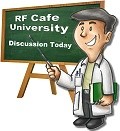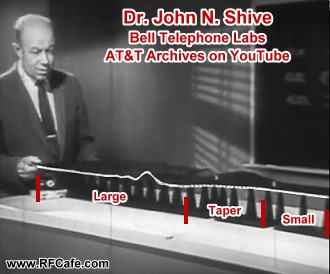The Shive Wave Machine - Bell Telephone Labs
|
|
1 | 2 | 3 | 4 | 5 | 6 | 7 | 8 | 9 | 10 | 11 | 12 | 13 | 14 | 15 | 16 | 17 | 18 | 19 | 20 | 21 | 22 | 23 | 24 | 25 | 26 | 27 | 28 | 29 | 30 | 31 | 32 | 33 | 34 | 35 | 36 | 37
Shive Wave Machine with tapered section transitioning between large and small sections. Sometime around 1985, I was enrolled in a second-semester physics class (AACC) while working on earning my BSEE. Along with covering topics like electricity, magnetism, heat conduction, optics, etc., my professor, a moonlighting oceanography instructor from the nearby U.S. Naval Academy, conducted a laboratory exercise wherein he wanted to demonstrate the action of sea waves breaking against the shore and underwater shelf discontinuities. He used an impressive contraption that was comprised of coplanar parallel metal rods that were attached in their centers to a spring steel bar for torsional continuity. The tips of the rods were painted white so that when the end bar was perturbed with a vertical impulse, a sinewave shape could be seen propagating along the length of the device - both an incident and, eventually, a reflected wave. Depending on whether the last bar at the far end of the device, which I now know is called a Shive Wave Machine, is free to move or held rigidly, the reflected wave would be either in phase or out of phase with the incident wave. He then attached to the far end a smaller Shive Wave Machine to demonstrate what happens when something between an open and shorted connection terminates the larger machine. Finally, he inserted a Shive Wave Machine section between the large and small machines that had rods that tapered linearly from the large to the small size. That addition caused the reflections in the initial section to nearly (but not totally) disappear. Upon watching the action of the Shive Wave Machine, I immediately recognized the parallel between its mechanical motions and those of electromagnetic signals on a transmission line (and in free space for that matter). The professor confirmed my assertion and noted that with his dedication to the mechanical aspects, he had not thought to relate it to electrical waves during a demonstration, although he certainly was aware it. I have written about this guy in the past, regarding him as being one of the more inspirational instructors I have had in all my engineering classes. He could work out any problem in my physics book (Halliday & Resnick), whether it be on gravitational forces, electric fields, black body radiation, or relativity. I have thought about the Shive Wave Machine often over the years, but never knew its name until I ran across a video of it on YouTube. I honestly cannot recall the website where I saw it posted or I would give credit to the author of the article for reminding me of it. The video is embedded below. Dr. John N. Shive, of Bell Telephone Laboratories, was the inventor. He also invented the phototransistor.
Video of the Shive Wave Machine being demonstrated by its inventor, Dr. John N. Shive, of Bell Telephone Laboratories.
Posted January 11, 2016 |
 "
"